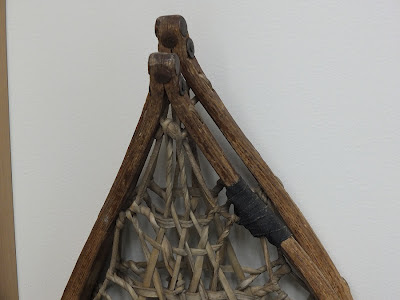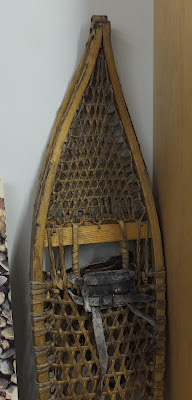A 1982 lecture by
David W. Arthurs, Field Archaeologist for the North Central Region of the Historical Planning and Research Branch of the then Ministry of Culture and Recreation
continued from previous post...WAPISCOGAMY HOUSE AND RED ROCK HOUSE and the early and late Hudson's Bay Company Fur Trade in Northern Ontario
As you will see, though the history of this post (Wapiscogamy House) parallels remarkably that of the next one, I'm going to talk about, the century that elapsed between their periods of construction had several major effects on the Hudson's Bay Company's approach to the fur trade.
We move now to the latter part of the 19th century, and to the HBC's operation in the Lake Superior area. Lake Superior had, of course, figured prominently in the French and North West Company fur trades. There were several posts along the shore, through the fur trade period, including those at Michipicoten, Pic River, Nipigon and Thunder Bay.
Perhaps the most important of these was Fort William at the mouth of the Kaministikwia River, the great inland headquarters of the North West Company.
Although the HBC continued to operate the post after the 1821 coalition with the N.W.C., in the mid to late 1800's, it was a mere shadow of its former greatness.
It was but one of a series of HBC posts, which included those at Michipicotin, Red Rock, Pays Plat, Pic and other spots along the shore at the mouth of the major rivers leading into the interior.
By the mid 19th century, a sophisticated transportation network had been developed on Lake Superior. Though large canoes were still in use, since the late 1830's the HBC had employed schooners, the Whitefish and later the Isobel, to carry goods among the north shore posts. This may be the Isobel docked at Fort William in the 1860's - symbolically, a steamer appears on the horizon, heralding the days of steamer transport in the Superior region in the second half of the century.
(as before - no photos are in our Archives to go with this lecture)
Although archaeologists and historians have done much research with Fort William and Michipicoten, surprisingly little attention has been paid to another post on the north shore, that in many ways typifies the later stages of the fir trade in the region. It is Red Rock House, at the mouth of the Nipigon River.
The post gets its name from the distinctive red and cream sedimentary rock that forms the cliffs at the mouth of the river it is a spot sacred to native people - somewhere hidden in the hills is an ancient quarry where stone was obtained to carve pipes and along the cliffs are pictographs - hundreds of symbols,
one of only 5 known rock art sites on Lake Superior - and perhaps the largest.
The most impressive figure is that of the mythical creature Maymaygweshi (or Rock Medicine Man) who guards the entrance to the Nipigon River.
Red Rock House began in 1859, as a couple of rough log buildings located along a small harbour on the river at the present site of the Nipigon Docks. A safe haven, at first for the HBC schooners Whitefish and Isobel, and later for steamboat traffic, the post was gradually to gain importance as a trans-shipment centre, located as it was on the important Nipigon River route to the interior. Originally, paralleling Wapiscogamy House somewhat, Red Rock House was established as an outpost to guard against the encroachment of American traders from the South Superior shore. It did little trade originally, but guarded the access to the valuable lake Nipigon country. From Red Rock House, canoe and boat brigades began the arduous journey up the River to Nipigon House a major HBC post located on the north west shore of Lake Nipigon.
The growth of the post was slow until the early 1870's. The CPR survey crews operated in the area in 1872-3 and rumours began to spread that Red Rock House was being considered as the site of the railhead, from which goods brought by steamer from Sault Ste. Marie would be distributed to the west.
The Chief Trader at the time, Robert Crawford, rapidly set about upgrading the post facilities, to include dock facilities, warehouses, and commodious officer's quarters. A spacious dwelling house was constructed at a cost of $5,000 with gingerbread under the eaves in the style of southern Ontario Georgian farmhouses.
Unfortunately, the people of Prince Arthur's Landing, through their political connections, had the present site of Thunder Bay chosen as the terminal. This dealt the death blow to the improvement of Red Rock House, and Crawford, who had gone against the wishes of the Honourable Company, was unceremoniously transferred to Ungava, where there was no wood for building material!
The construction of the railway across the north shore in the 1880's led to the collapse of the post as a distinct entity. The establishment of the station, and of several stores at the town plot, some distance from the post, took away from the retail business. For several years the post masters argued with the Company that a store should be established near the station. This was finally accomplished in 1899, and the empty buildings, being sadly in need of repair, were rented out to commercial fishermen. Although the HBC remains in Nipigon to this day (1982) the post faded away at the turn of the century, to be replaced by fishing concerns. (2012 HBC no longer in Nipigon).
One of the more interesting structures at the site was the stone powder magazine. Stone buildings of 19th century vintage are uncommon in this part of the world - the only other one, at Fort William, was torn down in the early 1900's.
There are references to the building in the archival documents as early as 1888, however, the date of its construction remains unknown.
We began our investigations of the building this past summer, with the hope of establishing its construction date, and of gathering data concerning the methods of construction.
The project was all the more urgent as during the construction of the new dock facilities the winter before, a bulldozer had seriously damaged the foundation walls at the time it stood almost a metre high. WE gridded off the area in 1 metre units, and selected the four intersecting the corners of the building.
The layers of soil surrounding the foundation were peeled away 3 cm. at a time, the location of artifacts plotted on graph paper, and soil removed passed through a screen to recover artifacts missed in trowelling.
As each unit was completed, a scaled profile was prepared for each wall of the excavation, and of the foundations themselves. Although we had hoped to recover artifacts such as china or glassware that would assist us in dating the structure, artifact recoveries were disappointingly few. We did gain some insights into the construction of the building not to be gotten from studying the photographs, or from the archival documents.
The build had been constructed of roughly trimmed blocks of the red sedimentary rock, available in the cliffs across the river from the site. These were held together with a coarse mortar. The interior of the building appears to have had a plaster of mortar, presumably to make it less damp. The floor appears to have been packed clay.
It had a roof of wood, to which sheets of metal had been tacked to retard the spread of fire. The rafters were set on rough hewn timbers fastened together at the corners with tongue and groove, that rested on the stone walls.
The most interesting aspect of the building was the foundations. They were set in a trench dug into the sandy sub-soil, large rocks and wooden planking had been laid in the bottom of the trench presumably to serve as footings to stabilize the walls as they were erected. The trench was then backfilled to the original ground level.
Although the excavations are not yet complete, we now have a fair idea of how this building was constructed. Though we are not certain of the date of construction, the plate cut nails in the structure to indicate a late 19th century construction date. By amalgamating the archaeological archival and photographic data, we will have a larger body of information on this late 19th century powder magazine.
To sum up, I've tried to give an outline of the early and late fur trade in Northeastern and North Central Ontario. There are several comparisons and contrasts that may be made - Wapiscogamy House was one of the first inland posts in the area, as Red Rock was one of the last. Both began as outposts, top protect the HBC trade and serve as jumping off points in a transportation network that, as it developed in sophistication, led them to become important posts in their own right both eventually declined, directly or indirectly as a result of improved inland transportation and finally the coming of the railway. One was fortified mainly to guard against attacking Indians and the traders of the competition, but probably also as a means of giving sense of security to the men who lived there so far from home. The other was unfortified and in territory that was gradually being settled. It was gradually absorbed into the expanding community that was to become the town of Nipigon































































